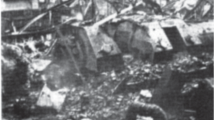Abstract
The possibility to stabilize the developing asynchronous rolling of the rotor over the stator under the conditions of power unit protections coming in action with different response times is considered. Asynchronous rolling of the rotor over the stator may develop when the rotating rotor comes in contact with the stator at high amplitudes of vibration caused by an abrupt loss of rotor balancing, by forced or self-excited vibration of the rotor, and by other factors. The danger of asynchronous rolling is connected with almost instantaneous development of self-excited vibration of the rotor when it comes in contact with the stator and with the rotor vibration amplitudes and forces of interaction between the rotor and stator dangerous for the turbine unit integrity. It is assumed that the turbine unit protection systems come in action after the arrival of signal of exceeding the permissible vibration level and produce commands to disconnect the generator from the grid, and to stop the supply of working fluid into the flow path, due to which an accelerating torque ceases to act on the turbine unit shaft. The protection system response speed is determined by a certain time t = ABtime that is taken for its components to come in action from the commencement of the event (application of the signal) to closure of the stop valves. The time curves of the main rolling parameters as functions of the ABtime value are presented. It is shown that the response time of existing protection systems is not sufficient for efficiently damping the rolling phenomenon, although the use of an electrical protection system (with the response time equal to 0.40–0.45 s) may have a positive effect on stabilizing the vibration amplitudes to a certain extent during the rolling and on smoothing its dangerous consequences. The consequences of rotor rolling over the stator can be efficiently mitigated by increasing the energy losses in the rotor-stator system (especially in the stator) and by fulfilling the recommendations of the machinery unit catastrophe prevention system.
Similar content being viewed by others
References
E. L. Poznyak, “Torsional shock arising in a shaft system as a result of an abrupt and severe loss of balancing,” Mashinoved., No. 5, 66–74 (1987).
V. F. Shatokhin, “Some proposals on preventing catastrophes connected with failures of turbine units,” Vestn. Mashinostr., No. 6, 25–31 (2007).
V. F. Shatokhin and S. D. Tsimmerman, “Predefiniteness of the development of a turbine unit failure process and examples of its consequences,” Aviats.-Kosm. Tekhn., Tekhnol. 8(44), 95–102 (2007).
I. Sh. Zagretdinov, A. G. Kostyuk, A. D. Trukhnii, and P. R. Dolzhanskii, “Destruction of the 300-MW turbine-generator unit at the Kashira district power station: causes, consequences, and conclusions,” Therm. Eng. 51(5), 345 (2004).
A. G. Kostyuk, V. F. Shatokhin, and O. A. Volokhovskaya, “Motion of an imbalanced rotor when it rubs against the stator,” Therm. Eng. 59(2), 87 (2012).
A. N. Nikiforov, “The Jeffcott-Laval generalized mathematical model of a rotor taking into account its slipping in case of its misalignment and coming in contact with the stator,” Vestn. Nauchno-Tekhn. Razv., No. 5 (57), 41–54 (2012).
A. G. Kostyuk, V. F. Shatokhin, and S. D. Tsimmerman, “Studying the motion of a rotor in the gap with its coming in contact with the stator after an instantaneous loss of balancing,” Vestn. Dvigatelestr., No. 3, 113–121 (2009).
V. F. Shatokhin and S. D. Tsimmerman, “The influence of parameters at the place in which the rotor comes in contact with the stator on the development of rolling after instantaneous loss of rotor balancing,” Aviats.-Kosm. Tekh., Tekhnol. 9(76), 87–96 (2010).
A. G. Kostyuk, V. F. Shatokhin, and S. D. Tsimmerman, “Numerical modeling of unsteady vibration excited after an abrupt loss of balancing of a multisupport rotor with its subsequent rolling over the stator,” Aviats.-Kosm. Tekh., Tekhnol. 8(85), 81–93 (2011).
A. G. Kostyuk, V. F. Shatokhin, and S. D. Tsimmerman, “Numerical modeling of unsteady vibration of a multisupport rotor entailing its rubbing against the stator,” Elektr. Stn., No. 9, 33–41 (2012).
V. F. Shatokhin and S. D. Tsimmerman, “Specific features pertaining to development of rolling of an unbalanced rotor over the stator,” Vestn. Dvigatelestr., No. 2, 105–112 (2012).
“The control, protection, and diagnostic system. A manual for protections and interlocks of IT14T-50-8.8/0.12,” in Measurement Technologies (Sarov, 2012).
Author information
Authors and Affiliations
Corresponding author
Additional information
Original Russian Text © V.F. Shatokhin, 2014, published in Teploenergetika.
Rights and permissions
About this article
Cite this article
Shatokhin, V.F. Studying the development of asynchronous rolling of the rotor over the stator with the turbine unit protection systems having different response times. Therm. Eng. 61, 514–523 (2014). https://doi.org/10.1134/S0040601514040077
Published:
Issue Date:
DOI: https://doi.org/10.1134/S0040601514040077



